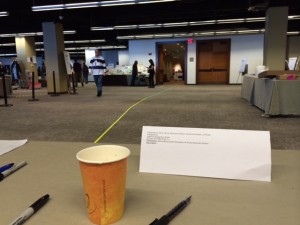Boskone in the blizzard
For the last few years, Boskone has been held at the BostonWestin Harborside – a seriously upscale hotel. Why this is the case, I do not know… you’d think that a less-expensive location would attract more attendees.  It’s a bit of a squeeze to be able to afford the weekend.
But I have to say that this year I actually appreciated the amenities.  Having returned to the day-job, being a bit more tired from that, and uncertain about my energy level after all the treatments of various kinds — it was nice to just pay the money and take it easy.

25 year old Macallan. The best scotch I’ve ever had in my life…
Park in the expensive hotel garage, dine at the restaurants.  Relax in the hotel lounge/bar/atrium, with the indoors birches, and gaze out the three-storey-tall wall of glass at the MAJOR BLIZZARD outside. Pretty nice.

In between the sessions of snowplowing.
I was on only two panels, which was about all I could reasonably handle this time around, I think.
One was on cross-influences between music and science fiction/fantasy, which evolved into mainly a discussion about how filk music has expanded from from jokey parodies and developed into simply music with sf/f themes. Â Â Much was said by persons far more erudite than myself, and I feel I learned a lot.
The second was on world-building: how we do it, and how we communicate it.  This was a lot of fun. My co-panelists were Myke Cole, Peadar O Guilin, Lauren Roy, and E. C. Ambrose (aka Elaine Isaak), who also served as moderator.
I have to say that Elaine is a brilliant moderator — as well as having a lot to say as a participant.  She kept things moving, brought up great topics, and did it all with grace and aplomb.
I believe that what made it so interesting was first, the range of viewpoints represented; and second, our willingness to step up and disagree with each other (in a civilized way). Myke set the tone on this, by announcing up front that he was by nature a very vehement person, and warned us that he’d state his opinions in a strong manner, but that it didn’t mean that he didn’t respect our opinions — it’s just the way he was. I now feel that every panel should begin with a similar announcement by someone, because we were off and running. I believe no one held back. This made for a lively exchange, and a good overview of all the different ways to make your world-building work.
What are those ways?
Well, there’s the minimalist approach (Myke’s choice), where you create just enough world to have the illusion of there being more world behind it — like the plywood cut-outs of houses used in old movie sets.  The reader creates the sense of the world by the clues and cues given by the author.
Then there’s the wide, deep, detailed world, of which the reader only sees the bit pertaining to the story at hand (As J.R.R. Tolkein did).
And there are all sorts of ranges in between the extremes.
And there’s my approach, which is a sort of feedback loop, where you might create some aspect of a world in order to justify a particular dramatic point, which aspect then generates other details about the world (or necessitates actual research!), which then in turn inspire further dramatic points — and repeat until the world or society reaches the required level of depth and breadth.
As for how your world is communicated: Elaine had a lovely demonstration (which she uses when teaching writing), where she has people take out a penny, and look at the penny, and see just how much the simple existence of this tiny object communicates about the society that uses it.   There are obvious things it tells us, such as that metal is used by this culture — but did you ever notice that there are two languages on a penny? And that there are examples of clothing, and architecture?  And she said more — I won’t tell it all.  But that was such a smart thing to say, and such a smart thing to make us notice.
And lots more was said — about research, and inspiration (Peadar spoke of looking for the extremes; I spoke of flipping expectations).   It was all fun and interesting.  I’d do that again, with the same line-up, in a heartbeat.
Non-paneling, just hanging around…
Jo Walton introduced me to Ada Palmer and Lauren Schiller of the a capella group Sassafrass, and we were treated to a couple of stunning tunes from the Norse Myth song cycle/play that Ada wrote.  Even with just the two singers, the songs were amazing, and moving.
At one point I actually borrowed a guitar and sang and played Buddy Mondlock’s “The Kid”, which I thought I could handle… but my voice is still shredded, and my breath control non-existent, and my fingers wouldn’t do all the fiddly bits of the arrangement I use, so I had to simplify on the fly… but it felt good. Time to put in some practice and get my serious chops back.
Here’s Buddy himself doing the song:
You know, I seem to be the only person who does the third verse these days (“I’m the kid who fell asleep at the movies…”).  Possibly because it’s rather a long song when it’s included… But it was on the lyric sheet included with the cassette (!) when I bought it ages ago, and I do love that verse.
Also, I had an autograph session!

The crowds at my autograph session
Oh, and I did a reading.
About which, more later.